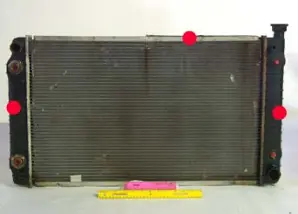RADIATOR
WHAT IS THE RADIATOR AND WHAT DO YOU NEED TO KNOW ABOUT BUYING A USED RADIATOR?
A car radiator is responsible for cooling the vehicle’s engine at high temperatures. When the vehicle’s engine temperature reaches a certain level, the vehicle’s thermostat will alert the radiator to circulate coolant through the engine's system.
The coolant will take up the heat on the engine and return it to the car radiator. At that point, the radiator will reduce the temperature of the coolant. When the coolant's temperature is lowered, it will then be released back to the vehicle’s engine.
Where is the radiator located?
The vehicle’s radiator is located under the hood between the engine and the front of the vehicle for front mounted engines. Cars that have rear mounted engines can have the radiator located at the front of the back of the vehicle.
Why is the radiator so important?
Your radiator is responsible for allowing your engine to run at high temperatures. A properly running radiator will prevent your vehicle from overheating and breaking down.
What does the radiator look like?
A car radiator has a large square of rectangular frame - about a couple of inches thick - and a cap. The cap is where the water or the coolant is inserted.
The radiator will also have several connectors to the water pump and the engine. The radiator will be made of conductive metals. The four main conductive metals found on radiators include the following:
- Cast iron
- Mild steel
- Stainless steel
- Aluminum
What are the signs of radiator problems?
Radiators are designed to last for a long time. On occasion, a car radiator may give you trouble. Here are some signs that your vehicle’s radiator is having issues:
- Your vehicle’s temperature reading is higher than normal.
- There is smoke coming out of the hood of your vehicle.
- There is a collection of green liquid under the hood of your car.
- There is rust in your cooling system.
- Low coolant
- Sludge in the radiator
What are the most common problems associated with radiators?
The most common problems that you will find in old radiators is that they will begin to leak after a while. The water and the antifreeze coolant is green. Therefore, if you find green, yellow or pinkish-red puddles under your car, then it is most likely a leak in the radiator.
Other common problems that you will find in an old radiator is rust. If you find rust build up on a radiator, then it is typically past its prime.
Finally, overheating is a problem for older radiators. Therefore, if you find that your vehicle’s temperature is higher than normal or if there is smoke coming from under the hood of your vehicle, then it is time to change the radiator.
What to look for in a used radiator?
When looking for a used radiator, you want to make sure that you have a part that will last. Here are the first things to inspect when look at used radiators:
Look for corrosion or stripped paint - Coolant that sits in a radiator for an extended period of time will cause the paint to strip as well as corrosion. If the radiator doesn’t have any corrosion or stripped paint, then that’s a good sign that the radiator did not leak any coolant.
Check the cooling cores - You will also want to check the cooling cores (also known as the cooling fins). The cores should not be bent, dented or broken due to age or an accident. The cooling cores or fins are responsible for dissipating heat out of the vehicle. Therefore, the cores or fins should be carefully checked.
